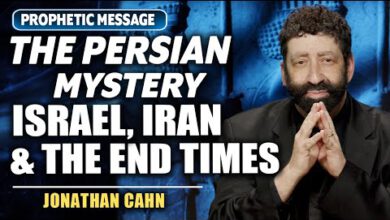The Mystery Of The Tav – Behind The Cross | Jonathan Cahn Sermon
The Mystery Of The Tav – Behind The Cross | Jonathan Cahn Sermon
When you invited Him into your life, it wasn’t that everything changed, but that you changed. This is why salvation is about becoming whole. He is the completion, the top, and through Him, you become complete. The power of the Messiah is to make you whole because He is the fulfillment of all things.
The letter “T” in the English alphabet comes from the Hebrew letter Tav, which is the modern version of Tav. You may already recognize the shape of the T, both in uppercase and lowercase, which resembles the shape of the cross. The Romans used this shape for crucifixion, and it’s believed that Jesus was crucified on this form of the cross, which signifies the end—the completion—of everything. The Tav represents the last, the final, the ending. In this context, the cross represents the end of all things—the end of sin, the end of the old.
The Messiah’s life ended on the cross, and the cross is where everything finds its conclusion. When Jesus said, “It is finished,” He revealed that the cross is the end point of everything. This means that the center of our faith isn’t that God will make us wealthy, reveal new doctrines, or grant us worldly desires; the center is the cross. It is at the cross that everything is brought to completion.
Linking this with the mystery we discussed last week about the tree of the knowledge of good and evil in the center of the garden, we understand that the cross is the final point. The cross is not just the end of all things, but the end of your sins specifically. Your sins are meant to end there. Bring your sins to the cross so they can be truly ended. Your sins, guilt, and shame were meant to be finished at the cross.
If you’re carrying burdens that you weren’t meant to carry, bring them to the cross. If you have unconfessed sin, it remains with you until you bring it to its end. Even if something from your past continues to haunt you, it hasn’t truly ended yet. You must bring it to the cross so it can be finished. The cross is the place where not only past sins are ended but present ones as well. If you’re still practicing old habits, behaviors, or sins from your past, they need to be brought to the cross—the place where all things are finished.
Once you bring these old ways, thoughts, and habits to the cross, they are ended. You can then live the new life that God has for you. As Paul said, “I am crucified with Christ, and I no longer live, but Christ lives in me.” This means that the old identity, the old you, has been brought to the cross and ended. Once you acknowledge that the old you is finished, you are no longer bound by your past sins, fears, guilt, shame, sorrow, or losses. The power of the cross allows you to be free.
The cross is the ultimate power to end everything that needs to be finished. Anything from your old, dark past that tries to rise again, bring it back to the cross—the place where all things are ended. The Tav and the Omega represent the end, and God is the ultimate end. But the end doesn’t only signify a conclusion; it also carries a deeper mystery, as shown in Psalm 118, which was read on Passover—the night Jesus was taken to be crucified.
Psalm 118 says, “The stone that the builders rejected has become the chief cornerstone.” In the Hebrew text, it refers to the stone that was rejected becoming the Rosh Pina, the chief cornerstone—where everything is made complete. This verse symbolizes the power of Jesus as the cornerstone of our faith, the end point of all things, yet the beginning of our new life in Him.
Write Your Prayer
JeriAnn - 2025-04-02 16:15:18
My 3 children to return to the Lord Jesus Christ. Andy, Amy Beth, and Emilee. They are in their 50’s and received the baptism of the Holy Ghost when they were children. Also each of my grandkids to come to the Lord and seek a personal relationship with Him. In the mighty name of Jesus!

S - 2025-04-04 06:18:56
Very bad leg pain...edema...plus digestive problems. Have a bad pain ... Doc tomorrow.